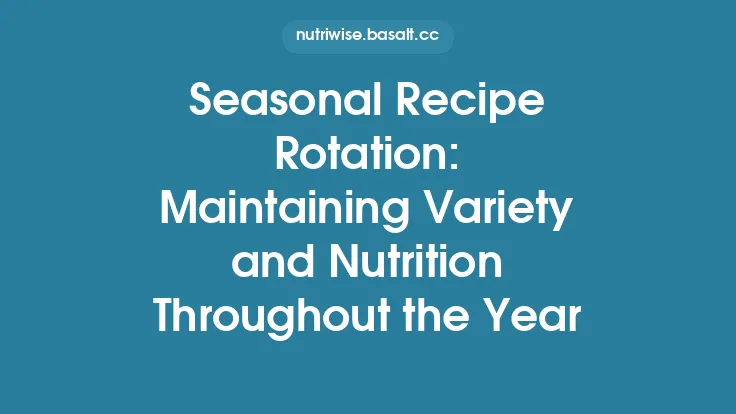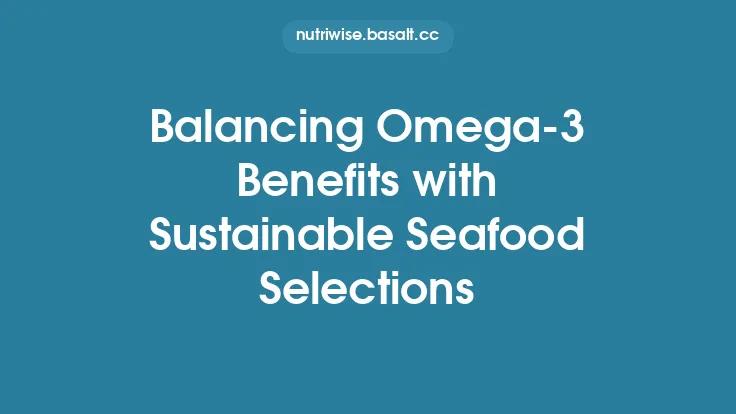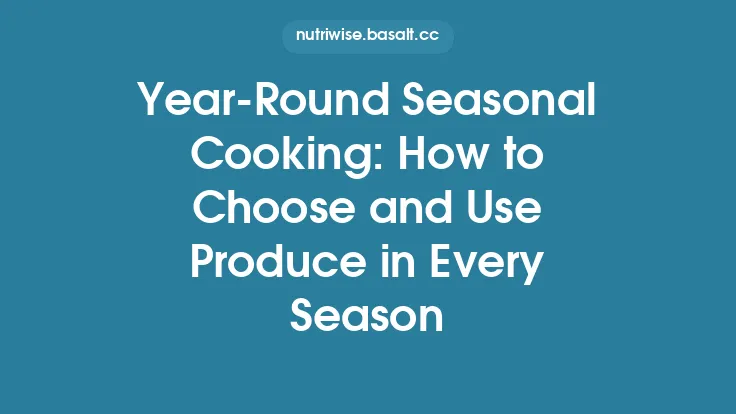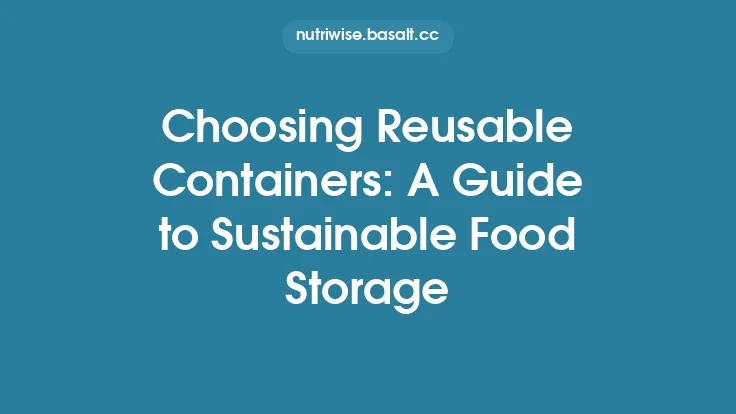The world’s oceans are in constant motion, and the creatures that inhabit them follow the rhythm of temperature, daylight, and food availability. Because of these natural cycles, most seafood species are only abundant—and therefore most responsibly harvested—during specific windows of the year. Understanding when and where these windows occur is the cornerstone of a truly sustainable seafood habit. By aligning our purchases with the seasonal peaks of local fisheries, we not only enjoy fresher, better‑tasting products, but we also help keep fish populations healthy, reduce the carbon footprint of transportation, and support the coastal economies that depend on responsible harvests.
Understanding Seasonal Dynamics in Marine Ecosystems
Marine species are governed by a suite of biological and environmental drivers that dictate when they are most plentiful:
| Driver | How It Shapes Seasonality |
|---|---|
| Water Temperature | Many fish and shellfish have optimal temperature ranges for growth, spawning, and migration. For example, cold‑water species such as cod and haddock thrive in the cooler months of higher latitudes, while warm‑water species like snapper and grouper peak in summer when surface temperatures rise. |
| Photoperiod (Day Length) | Changes in daylight trigger hormonal responses that cue spawning events. Species that spawn in spring often have larvae that develop during the nutrient‑rich spring bloom, leading to a surge in juvenile abundance later in the year. |
| Plankton Blooms | The availability of plankton—both phytoplankton and zooplankton—directly influences the food supply for filter‑feeders (e.g., mussels, oysters) and the early life stages of many fish. Seasonal upwelling zones, where deep, nutrient‑rich water rises to the surface, create predictable peaks in plankton productivity. |
| Migration Patterns | Pelagic species such as tuna, mackerel, and certain sharks undertake long‑distance migrations to follow prey or reach spawning grounds. Their presence in a given region is therefore highly seasonal. |
| Reproductive Cycles | Many crustaceans (e.g., crab, lobster) have defined molting and mating periods. Harvesting during post‑molt phases, when the animal has a hard shell, ensures both product quality and that a sufficient number of individuals remain to reproduce. |
These drivers interact in complex ways, but the net result is a set of predictable “windows of abundance” that can be mapped and used to guide consumer choices.
Regional Seasonal Calendars – A Geographic Overview
Because oceanographic conditions differ dramatically from one coast to another, a truly useful seasonal guide must be broken down by region. Below is a snapshot of the most common sustainable options in several key fishing areas, organized by the months when they are typically at their peak.
Northeast United States (Maine to New Jersey)
| Species | Peak Months | Typical Harvest Method |
|---|---|---|
| Atlantic cod (wild) | November – March | Trawl & hook‑and‑line |
| Winter flounder | December – February | Bottom trawl |
| Sea scallops | June – September | Dredge (subject to seasonal closures) |
| American lobster | June – December (with regional variations) | Pot gear |
| Blue mussels | Year‑round, but highest quality in spring | Hand‑raked beds |
Pacific Northwest (Washington, Oregon, British Columbia)
| Species | Peak Months | Typical Harvest Method |
|---|---|---|
| Pacific halibut | May – September | Longline |
| Pacific salmon (sockeye, coho) | July – October | Gillnet & purse seine (strict quotas) |
| Dungeness crab | November – June (varies by sub‑region) | Pot gear |
| Geoduck (clam) | Late summer – early fall | Hand‑raked |
| Razor clams | October – March | Hand‑raked |
Gulf of Mexico & South Atlantic (Florida to Texas)
| Species | Peak Months | Typical Harvest Method |
|---|---|---|
| Red snapper (subject to strict management) | May – September | Hook‑and‑line |
| Gulf shrimp (white, brown) | March – June | Trawl (seasonal closures) |
| Gulf menhaden (used for fish oil, not direct consumption) | June – August | Purse seine |
| Stone crab (for claws) | October – May | Pot gear |
| Oysters (wild) | Year‑round, with higher yields in summer | Hand‑raked beds |
Atlantic Canada (Nova Scotia, Newfoundland)
| Species | Peak Months | Typical Harvest Method |
|---|---|---|
| Snow crab | May – August | Pot gear |
| Atlantic mackerel | June – September | Mid‑water trawl |
| Haddock | December – March | Bottom trawl |
| Atlantic herring | April – June | Mid‑water trawl |
| Wild Atlantic salmon (limited) | July – September | Gillnet (strict quotas) |
Mediterranean (Spain, Italy, Greece, Turkey)
| Species | Peak Months | Typical Harvest Method |
|---|---|---|
| European anchovy | April – June | Purse seine |
| Sardine (Sardina pilchardus) | May – August | Mid‑water trawl |
| Octopus (Octopus vulgaris) | Summer (June – August) | Hand‑caught |
| Mediterranean mussels | Year‑round, peak in spring | Rope culture (low impact) |
| Red mullet | September – November | Hook‑and‑line |
These tables are illustrative rather than exhaustive; local fishery agencies publish detailed calendars that reflect annual variations in stock assessments and environmental conditions.
How to Locate Sustainable Seasonal Seafood
Finding the right product at the right time requires a combination of local knowledge, reliable data sources, and a willingness to ask the right questions.
- Visit Direct‑Sale Outlets
- Fish markets and wharfs: Vendors who source directly from local boats are often the first to know when a species is in season. Look for signage indicating “in‑season” or ask the fishmonger about recent landings.
- Community‑Supported Fisheries (CSFs): While not the focus of a separate article, CSFs operate on a subscription model that delivers a weekly or bi‑weekly box of whatever is currently abundant, automatically aligning your diet with seasonal availability.
- Leverage Government and Academic Resources
- Regional fishery management councils (e.g., New England Fishery Management Council, Pacific Fishery Management Council) publish seasonal harvest reports, quota updates, and closure notices.
- University extension services often maintain “seasonal seafood guides” for their state or province, summarizing the best times to buy locally caught fish and shellfish.
- Use Digital Platforms
- Seasonal seafood apps (e.g., “Seafood Watch” by the Monterey Bay Aquarium, “FishTrack”) allow you to filter by region and month, showing which species are currently recommended.
- Online market places that partner directly with certified fisheries often tag products with “in‑season” badges.
- Check Local Restaurant Menus
Chefs who prioritize local sourcing will typically rotate their menu to reflect the freshest catch. If a restaurant highlights a particular fish as “local” and “seasonal,” it’s a good indicator that the product is both abundant and responsibly harvested.
- Ask About Harvest Method and Origin
Even within a season, the method of capture can affect sustainability. While the article does not delve into certification specifics, it is still prudent to inquire whether the fish was taken using gear that minimizes habitat impact (e.g., hook‑and‑line, pots) and whether the fishery adheres to regional management plans.
Interpreting Seasonal Availability Data
Raw data on catch volumes and stock assessments can be intimidating, but a few key metrics help translate numbers into actionable buying decisions.
| Metric | What It Tells You | How to Use It |
|---|---|---|
| Total Allowable Catch (TAC) | The maximum amount of a species that can be harvested in a given year, set by management bodies. | If the TAC is near its limit early in the season, expect reduced availability later; plan purchases early. |
| Seasonal Closure Dates | Periods when fishing for a species is prohibited to protect spawning aggregations. | Avoid buying that species during closure windows; look for alternative in‑season options. |
| Spawning Stock Biomass (SSB) | The reproductive portion of the population; a high SSB indicates a healthy stock. | Species with robust SSB are generally safer to consume; low SSB may signal the need for caution even if the species is technically “in season.” |
| Recruitment Indices | Measures of how many young fish are entering the population. | Strong recruitment often precedes a future abundance surge, suggesting that a species may become more readily available in the next season. |
| Environmental Indicators | Sea surface temperature anomalies, chlorophyll concentrations, and upwelling indices. | These can forecast shifts in seasonal peaks; for example, a cooler-than-average summer may delay the peak of warm‑water species. |
Most regional fishery agencies provide these metrics in plain language summaries. When in doubt, a quick phone call to the local fishery office can clarify whether a species is truly abundant or if a temporary surge is masking longer‑term concerns.
Planning Meals Around Seasonal Seafood
Integrating seasonal seafood into your weekly menu can be both exciting and practical. Here are some strategies to make the most of the freshest options:
- Create a Seasonal Shopping List
- Start with a regional calendar and note the species that are at their peak.
- Pair each fish or shellfish with complementary produce that is also in season (e.g., spring asparagus with early‑season cod, summer corn with Gulf shrimp).
- Batch‑Cook and Preserve
- When a favorite species is abundant, consider preparing larger quantities and freezing portions for later use. Proper flash‑freezing preserves texture and flavor, extending the seasonal benefit.
- For shellfish such as mussels or clams, short‑term refrigeration (1–2 days) is ideal; for longer storage, blanch and freeze.
- Explore Simple Preparations
- Seasonal fish often shines with minimal intervention: a quick sear, a light grill, or a gentle poach. This respects the natural flavor and reduces the need for heavy sauces or marinades.
- Shellfish can be steamed or baked with herbs and citrus, highlighting their freshness.
- Rotate Species to Avoid Monotony
- Use the calendar to plan a rotating roster: cod in winter, scallops in early summer, crab in fall, and so on. This not only diversifies your diet but also spreads demand across multiple stocks.
- Incorporate By‑Product Utilization
- When buying whole fish, make use of heads, bones, and shells to create stocks or broths. This practice maximizes the nutritional yield and reduces waste, aligning with broader sustainability goals.
Environmental and Economic Benefits of Seasonal Choices
Choosing seafood that aligns with its natural peak yields tangible advantages beyond the plate:
- Reduced Carbon Footprint
Seasonal, locally sourced fish travel shorter distances and often require less refrigeration, cutting greenhouse‑gas emissions associated with transport and storage.
- Lower Pressure on Over‑Exploited Stocks
By focusing demand on species that are naturally abundant, we alleviate fishing pressure on vulnerable populations that may be out of season or under strict quotas.
- Support for Coastal Communities
Seasonal harvests provide a steady flow of income for small‑scale fishers, who rely on predictable market windows to plan their operations and invest in sustainable gear.
- Enhanced Food Quality and Nutrition
Fish caught at the height of its natural cycle typically contains optimal levels of omega‑3 fatty acids, protein, and micronutrients, delivering better health outcomes for consumers.
- Resilience to Market Volatility
When consumers base purchases on seasonal availability rather than year‑round imports, the market becomes less susceptible to sudden price spikes caused by supply disruptions.
Adapting to Climate Variability and Shifts in Seasonality
Climate change is reshaping oceanic conditions, leading to observable shifts in the timing and location of peak abundance for many species. To stay ahead:
- Monitor Long‑Term Trend Reports
Agencies such as NOAA and the International Council for the Exploration of the Sea (ICES) publish annual assessments that highlight changes in spawning times, migration routes, and stock health.
- Embrace Flexible Planning
Instead of rigidly adhering to a static calendar, treat seasonal guides as living documents. If a species appears earlier or later than usual, adjust your menu accordingly.
- Diversify Species Selection
Building a broader palate for multiple species reduces reliance on any single stock, making your diet more resilient to unexpected fluctuations.
- Participate in Citizen‑Science Initiatives
Programs that collect data on local catches, beach strandings, or water temperature can feed into larger scientific models, helping refine future seasonal forecasts.
Tools and Resources for Ongoing Seasonal Tracking
| Resource | Format | What It Offers |
|---|---|---|
| State/Provincial Fishery Websites | Web portals | Up‑to‑date seasonal closures, TAC updates, and harvest advisories. |
| Seafood Seasonal Apps (e.g., “FishTrack,” “Seasonal Catch”) | Mobile app | Interactive maps, push notifications for opening windows, and recipe suggestions. |
| Local Extension Newsletters | Email / print | Region‑specific tips, upcoming fishery events, and market highlights. |
| Marine Research Institution Reports (e.g., Scripps Institution, Woods Hole) | PDF / online dashboards | In‑depth analyses of climate impacts on species distribution. |
| Social Media Groups for Coastal Communities | Facebook, Instagram | Real‑time anecdotes from fishers about current catches and conditions. |
By integrating at least one of these tools into your routine, you can maintain a dynamic, evidence‑based approach to sustainable seafood consumption.
Putting It All Together
A seasonal seafood strategy is more than a checklist; it is a mindset that respects the natural rhythms of marine life and the communities that depend on them. By:
- Learning the biological drivers that dictate when species are most abundant,
- Consulting regional calendars to identify peak windows,
- Seeking out local, direct‑sale outlets and reliable data sources,
- Interpreting management metrics to confirm sustainability,
- Planning meals that celebrate the freshest catches, and
- Staying adaptable in the face of climate‑driven changes,
you can enjoy delicious, nutrient‑rich seafood while contributing to the long‑term health of the oceans. The next time you walk into a fish market, let the season guide your choice, and you’ll be part of a growing movement that turns the tide toward a more sustainable, ethical food system.





